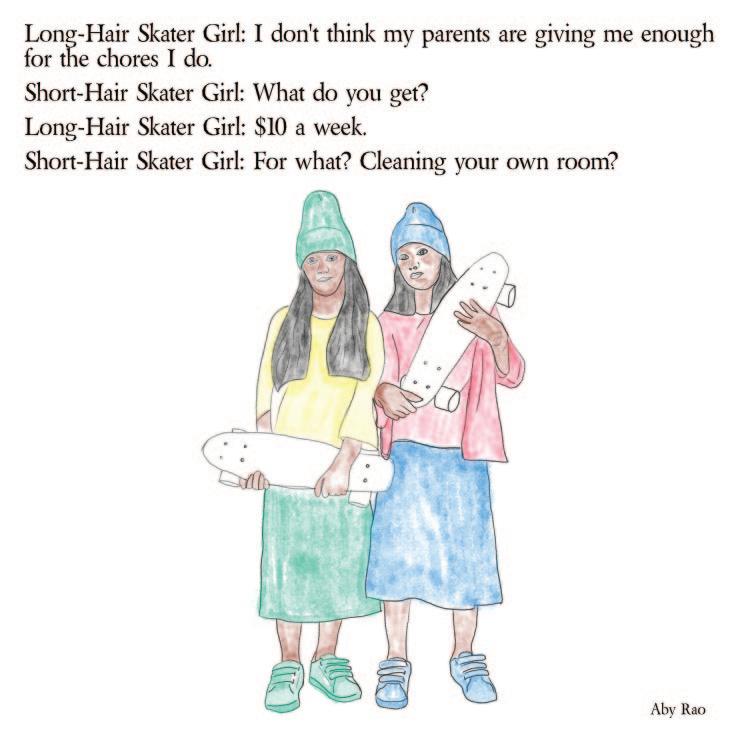Kids and Money
start paying some allowance somewhere along the line; of course, at what age is a key question but I am just talking about the concept here. This is to be done only after kids show signs that they can pitch in with chores. Why should they be paid, albeit very small amount, when they should be helping Mom and Dad with such chores anyway is the nagging question. Remember, all this is done just to create some respect for that almighty dollar. When they get some money for their work and can start thinking about what to do with it, then the concept of banking at least some of it and seeing it grow comes in the picture. A trivial matter, as it seems, but the concept of money growing over time is a powerful one and children should be indoctrinated to that thinking at the appropriate age. Parents can also start discussing what to do when you put money aside. For a 9-year-old, perhaps, it is a bit abstract, but a 15-year-old, probably, can see the concept of growing money and can imagine how much money they will have in 5/10/15 years. It is important to develop their mind to offset some instant gratification of spending it. Neale Godfrey, author of Money Doesn’t Grow on Trees: A Parent’s Guide to Raising Financially Responsible Children, likes to instill lessons about budgeting early. She even advises designating different allocations for different purposes like 10 percent for charity, 30 percent for quick cash for immediate gratification, and 30 percent for the medium term like buying laptop. You get the picture. Hardest part, I think, for a child to understand is how slow the money is growing when it is put in a bank account for growing and future use. Opening an account is easy at many institutions. Increasingly banks are opening branches in middle schools and high schools. CapitalOne has taken those steps already in a few locations. The Federal Deposit Insurance Corp. (FDIC) works with banks to teach children about money and encourage saving. Currently there are 76 such banks in the FDIC’s Youth Banking Network. Even though I would not recommend anybody to go for a Debit card, an exception must be made about that when it comes to children. Children cannot get a credit card unless cosigned by the parents and that is a no-no. Debit card has very many disadvantages, but for a few years, until they become 18, let them see how quickly the money disappears from their account when they purchase something with their hardearned cash. Debit card can be capped at a small amount. The child can be taught to contribute to their own 529k plans too, slowly of course. But before that, they will be more excited to contribute towards their own jam box or cell phone or something similar.
How to Prepare Your Kids and Yourself for a Healthy and Productive Financial Relationship Personal Finances by Mo Vidwans
Our granddaughter, when she was about 3 years old, loved to play with a toy cash register and mainly sell us make believe stuff that she didn’t have and we didn’t want; but she loved to play the role of a cashier, handling all that fake cash in the register. That went on for a while. My wife and I were hoping that it could be a start of a very bright future, of basically dealing with money but it seems that it may not materialize. Her interests are now different, but she is only just over 5. Teaching children about money and even more importantly how to handle it responsibly should be a burning question in the minds of all parents. The best way for kids to understand money is for them to earn it with their own blood, sweat and mostly tears; without that it is not very meaningful. If someone gives you money, like many grandparents do, it does not carry the same significance and its different from if the person receiving it busted his/her rear end for it. Of course, my granddaughter is not ready to earn money that way because she is just too young but after the kids show signs that they are ready for it or at least understand what is involved in doing the chores, they can certainly pitch in – putting toys away or clean their room or put dirty clothes in the hamper or in a specific place. As they get older, they can set or clean the dinner table, help with the laundry or walk the dog or even do some light yardwork. The best way to get children to understand money is to get them to respect it. If the toys and other things of pleasure keep flowing from parents and grandparents easily enough without even wanting/expecting it, the value of such things in their mind is very trivial. Such toys get shoved in the corner and probably never get a second look. On the other hand, if they have worked for it, even if it is just slightly, then the significance that item carries in their mind is different. The best way for children to respect money is for them to earn it; without that it is not much meaningful. If someone just gives you money, it is different from when you worked hard to earn it. Say your child spends major part of a day shoveling snow and clearing driveways and earns $50 for it and then your grandma gave him $50 just like that to keep. If one of those goes through a hole in your pocket or you forget it in the pocket and Mo Vidwans gets laundered, which one feels worse? is an independent, board certified financial planner. For details visit, Even though it is debatable, experts say parents should VidwansFinancial.com, call 984-888-0355 or write to: mpvidwans@yahoo.com Saathee.com
60
April 2021










